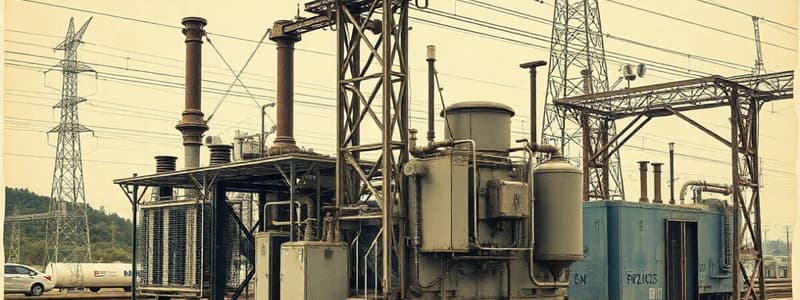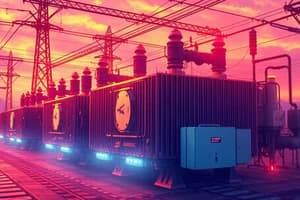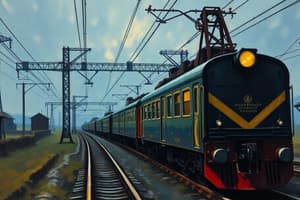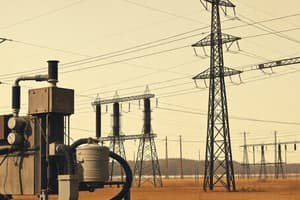Podcast
Questions and Answers
What is the primary voltage for the feeders that are used to support the overhead equipment for traction?
What is the primary voltage for the feeders that are used to support the overhead equipment for traction?
- 25 kV (correct)
- 27.5 kV
- 23.75 kV
- 30 kV
What is the permissible voltage variation range for the bus bars at the grid sub-station?
What is the permissible voltage variation range for the bus bars at the grid sub-station?
- $27,500 V$ to $23,750 V$ (correct)
- $23,000 V$ to $29,000 V$
- $20,000 V$ to $27,500 V$
- $25,000 V$ to $30,000 V$
How is the single-phase traction load managed to prevent unbalance in the 3-phase grid system?
How is the single-phase traction load managed to prevent unbalance in the 3-phase grid system?
- By cyclic tapping across different phases (correct)
- By reducing the voltage to lower levels
- By using transformers
- By using only one phase for traction
Which component ensures that the voltage does not exceed 27.5 kV at the feeding post?
Which component ensures that the voltage does not exceed 27.5 kV at the feeding post?
What is the maximum allowable instantaneous voltage unbalance at the point of common coupling in the grid supply system?
What is the maximum allowable instantaneous voltage unbalance at the point of common coupling in the grid supply system?
What type of operation is the traction sub-station designed for?
What type of operation is the traction sub-station designed for?
What connects one end of the secondary winding of the transformer at the sub-station?
What connects one end of the secondary winding of the transformer at the sub-station?
What is the maximum speed allowed when the runners of the section insulator assembly are not installed in the first one-third of the span?
What is the maximum speed allowed when the runners of the section insulator assembly are not installed in the first one-third of the span?
What kind of structures are used to ensure mechanical independence of the overhead equipment (OHE) for each track?
What kind of structures are used to ensure mechanical independence of the overhead equipment (OHE) for each track?
What is the maximum speed potential for an OHE designed with a span of 72 m and a tension of 1000 kgf in both contact and catenary wires?
What is the maximum speed potential for an OHE designed with a span of 72 m and a tension of 1000 kgf in both contact and catenary wires?
What precaution is necessary when approaching an unwired track with an electric locomotive?
What precaution is necessary when approaching an unwired track with an electric locomotive?
What should a driver be ready to do when approaching a neutral section indicated by warning boards?
What should a driver be ready to do when approaching a neutral section indicated by warning boards?
What is indicated about electric traffic during a power block on both OHE sub-sectors?
What is indicated about electric traffic during a power block on both OHE sub-sectors?
What is the purpose of static type voltage regulators in the railways?
What is the purpose of static type voltage regulators in the railways?
Where are static type voltage regulators typically installed?
Where are static type voltage regulators typically installed?
What is the duty of the Traction Power Controller (TPC) during his shift?
What is the duty of the Traction Power Controller (TPC) during his shift?
What kind of emergency provision can be found at large stations?
What kind of emergency provision can be found at large stations?
How often is the Remote Control Centre (RCC) manned?
How often is the Remote Control Centre (RCC) manned?
What is the maximum duration a power block is likely to last?
What is the maximum duration a power block is likely to last?
Which of the following personnel is in charge of switching operations on the railway system?
Which of the following personnel is in charge of switching operations on the railway system?
What arrangement is suggested for authority communication during a power block?
What arrangement is suggested for authority communication during a power block?
What is the purpose of staggering the contact wire in OHE systems?
What is the purpose of staggering the contact wire in OHE systems?
What defines a regulated OHE system?
What defines a regulated OHE system?
How far apart are uninsulated overlap spans in OHE systems?
How far apart are uninsulated overlap spans in OHE systems?
What is the role of section insulators in OHE systems?
What is the role of section insulators in OHE systems?
Why are insulated overlaps provided in OHE systems?
Why are insulated overlaps provided in OHE systems?
What is the maximum distance OOHE conductors can be terminated with an overlap?
What is the maximum distance OOHE conductors can be terminated with an overlap?
What factor typically dictates the spans adopted for catenary support intervals?
What factor typically dictates the spans adopted for catenary support intervals?
What happens when pantographs transition between OHE systems?
What happens when pantographs transition between OHE systems?
What is the length of overlap in insulated overlaps in OHE systems?
What is the length of overlap in insulated overlaps in OHE systems?
At what speed are section insulator assemblies designed to be effective?
At what speed are section insulator assemblies designed to be effective?
What is the primary purpose of the Emergency Control Circuit?
What is the primary purpose of the Emergency Control Circuit?
Where are emergency telephone socket boxes installed?
Where are emergency telephone socket boxes installed?
Which of the following is NOT a purpose of walkie-talkie sets in maintenance depots?
Which of the following is NOT a purpose of walkie-talkie sets in maintenance depots?
Who primarily operates the Emergency Control Circuit?
Who primarily operates the Emergency Control Circuit?
What is the role of Hot Line Communication?
What is the role of Hot Line Communication?
What interval is recommended for placing emergency telephone socket boxes along the track?
What interval is recommended for placing emergency telephone socket boxes along the track?
Which of the following is a function of the independent inter-communication circuit?
Which of the following is a function of the independent inter-communication circuit?
Which personnel are equipped with portable emergency telephones?
Which personnel are equipped with portable emergency telephones?
What is a key benefit of providing walkie-talkie sets in maintenance depots?
What is a key benefit of providing walkie-talkie sets in maintenance depots?
Which of the following roles is NOT involved in the Hot Line Communication circuit?
Which of the following roles is NOT involved in the Hot Line Communication circuit?
What is the standard capacity of the transformers typically installed at traction sub-stations?
What is the standard capacity of the transformers typically installed at traction sub-stations?
Which arrangement describes when the Railway owns certain circuit breakers at sub-stations while the Supply Authority manages all other equipment?
Which arrangement describes when the Railway owns certain circuit breakers at sub-stations while the Supply Authority manages all other equipment?
How is continuity of power supply ensured at traction sub-stations?
How is continuity of power supply ensured at traction sub-stations?
What is a typical distance between traction sub-stations along electrified sections?
What is a typical distance between traction sub-stations along electrified sections?
Which of the following explosion prevention measures is commonly installed at traction sub-stations?
Which of the following explosion prevention measures is commonly installed at traction sub-stations?
How does the Railway receive its power supply if it runs its own transmission lines?
How does the Railway receive its power supply if it runs its own transmission lines?
What is the role of the Traction Power Controller regarding the 25 kV feeder circuit breakers?
What is the role of the Traction Power Controller regarding the 25 kV feeder circuit breakers?
What is the main function of the Emergency Control Circuit in the railway system?
What is the main function of the Emergency Control Circuit in the railway system?
Which personnel are typically provided with portable emergency telephones?
Which personnel are typically provided with portable emergency telephones?
What interval is recommended for the placement of emergency telephone socket boxes along the railway track?
What interval is recommended for the placement of emergency telephone socket boxes along the railway track?
What purpose do walkie-talkie sets serve in maintenance depots?
What purpose do walkie-talkie sets serve in maintenance depots?
What does the Hot Line Communication circuit primarily connect?
What does the Hot Line Communication circuit primarily connect?
What is the purpose of a 'Neutral Section' in the overhead equipment system?
What is the purpose of a 'Neutral Section' in the overhead equipment system?
What is referred to as a 'sub-sector' in the overhead equipment management?
What is referred to as a 'sub-sector' in the overhead equipment management?
Why are warning boards placed in advance of the neutral section?
Why are warning boards placed in advance of the neutral section?
What are 'interruptors' used for at feeding posts?
What are 'interruptors' used for at feeding posts?
What feature does a sectioning and paralleling post (SP) provide?
What feature does a sectioning and paralleling post (SP) provide?
What type of isolators are provided for electric loco running sheds?
What type of isolators are provided for electric loco running sheds?
How are 'elementary sections' created in the overhead equipment system?
How are 'elementary sections' created in the overhead equipment system?
What does the term 'earthing heels' refer to in the context of overhead equipment?
What does the term 'earthing heels' refer to in the context of overhead equipment?
What is the expected functionality of manually operated interrupters at watering stations?
What is the expected functionality of manually operated interrupters at watering stations?
What is the role of the bridging interruptors in the overhead equipment system?
What is the role of the bridging interruptors in the overhead equipment system?
What type of equipment is typically installed to protect each sub-sector from voltage surges?
What type of equipment is typically installed to protect each sub-sector from voltage surges?
How many interruptors are normally provided at each Sub-Sectioning Post (SSP) in a double track section?
How many interruptors are normally provided at each Sub-Sectioning Post (SSP) in a double track section?
Where is the 25 kV AC supply tapped to ensure a reliable supply of 240V?
Where is the 25 kV AC supply tapped to ensure a reliable supply of 240V?
What is the primary purpose of auxiliary transformers installed at posts?
What is the primary purpose of auxiliary transformers installed at posts?
What occurs with the bridging interruptors under normal operation conditions?
What occurs with the bridging interruptors under normal operation conditions?
What type of posts are occasionally used for sectioning but do not support paralleling of tracks?
What type of posts are occasionally used for sectioning but do not support paralleling of tracks?
What provides accommodation for remote control equipment and other essential devices?
What provides accommodation for remote control equipment and other essential devices?
What is typically monitored at switching stations using potential transformers?
What is typically monitored at switching stations using potential transformers?
What is the role of lightning arresters in the sub-sector equipment?
What is the role of lightning arresters in the sub-sector equipment?
What is the primary purpose of the Traction Loco Control circuit?
What is the primary purpose of the Traction Loco Control circuit?
Which circuit is primarily responsible for train movements within a section?
Which circuit is primarily responsible for train movements within a section?
What type of communication does the Traction Power Control circuit focus on?
What type of communication does the Traction Power Control circuit focus on?
Which personnel primarily operates the Dy.Control Telephone circuit?
Which personnel primarily operates the Dy.Control Telephone circuit?
What is a key benefit of having multiple independent telephone circuits in electrified railway sections?
What is a key benefit of having multiple independent telephone circuits in electrified railway sections?
Which circuit is specifically used for continuous monitoring of wagon movements?
Which circuit is specifically used for continuous monitoring of wagon movements?
Which of the following offices is NOT connected to the Train Control/Section Control circuit?
Which of the following offices is NOT connected to the Train Control/Section Control circuit?
For managing all power supply communications, which circuit is utilized?
For managing all power supply communications, which circuit is utilized?
Which of the following statements accurately describes the role of the Section Controller?
Which of the following statements accurately describes the role of the Section Controller?
The connections for the Traction Loco Control circuit include which of the following?
The connections for the Traction Loco Control circuit include which of the following?
Flashcards
Transformer Step-Down Voltage
Transformer Step-Down Voltage
Transformers reduce grid voltage to 25 kV for traction overhead equipment (OHE).
25 kV Feeders
25 kV Feeders
Carry power from substations to feeding posts near tracks, each controlled by a single-pole circuit breaker.
Voltage Regulation Limits
Voltage Regulation Limits
Bus bar voltage at substations must vary between 23,750 V and 27,500 V (+10% and -5% from 25,000V).
Transformer Tappings
Transformer Tappings
Signup and view all the flashcards
Single-phase Traction Load
Single-phase Traction Load
Signup and view all the flashcards
Voltage Unbalance Limits
Voltage Unbalance Limits
Signup and view all the flashcards
Cyclic Tapping at Substations
Cyclic Tapping at Substations
Signup and view all the flashcards
Power Block on OHE
Power Block on OHE
Signup and view all the flashcards
Signal Supply Outages
Signal Supply Outages
Signup and view all the flashcards
Portable Generators
Portable Generators
Signup and view all the flashcards
Standby Diesel Generators
Standby Diesel Generators
Signup and view all the flashcards
Voltage Fluctuations
Voltage Fluctuations
Signup and view all the flashcards
Static Voltage Regulators
Static Voltage Regulators
Signup and view all the flashcards
Remote Control Centre (RCC)
Remote Control Centre (RCC)
Signup and view all the flashcards
Traction Power Controller (TPC)
Traction Power Controller (TPC)
Signup and view all the flashcards
Section Controllers
Section Controllers
Signup and view all the flashcards
Emergency Control Circuit
Emergency Control Circuit
Signup and view all the flashcards
Hot Line Communication
Hot Line Communication
Signup and view all the flashcards
Walkie-Talkie Sets
Walkie-Talkie Sets
Signup and view all the flashcards
Emergency Telephone
Emergency Telephone
Signup and view all the flashcards
TPC
TPC
Signup and view all the flashcards
Power Blocks
Power Blocks
Signup and view all the flashcards
Divisional Officers
Divisional Officers
Signup and view all the flashcards
Maintenance Depots
Maintenance Depots
Signup and view all the flashcards
Walkie Talkie Communication purposes
Walkie Talkie Communication purposes
Signup and view all the flashcards
Inter-communication circuit
Inter-communication circuit
Signup and view all the flashcards
Section Insulator Runners Facing Direction
Section Insulator Runners Facing Direction
Signup and view all the flashcards
Mechanical Independence of OHE Track
Mechanical Independence of OHE Track
Signup and view all the flashcards
Flexible Head-Span
Flexible Head-Span
Signup and view all the flashcards
Maximum OHE Span Speed Potential
Maximum OHE Span Speed Potential
Signup and view all the flashcards
Unwired Track Warning
Unwired Track Warning
Signup and view all the flashcards
Staggered Contact Wire
Staggered Contact Wire
Signup and view all the flashcards
Overlap Spans (OHE)
Overlap Spans (OHE)
Signup and view all the flashcards
Uninsulated Overlaps
Uninsulated Overlaps
Signup and view all the flashcards
Insulated Overlaps
Insulated Overlaps
Signup and view all the flashcards
Regulated OHE
Regulated OHE
Signup and view all the flashcards
Unregulated OHE
Unregulated OHE
Signup and view all the flashcards
Section Insulator Assembly
Section Insulator Assembly
Signup and view all the flashcards
Pantograph Glide Distance (Curves)
Pantograph Glide Distance (Curves)
Signup and view all the flashcards
Pantograph Glide Distance (Straight Runs)
Pantograph Glide Distance (Straight Runs)
Signup and view all the flashcards
Conductor Overlap Interval
Conductor Overlap Interval
Signup and view all the flashcards
Power Supply Arrangements
Power Supply Arrangements
Signup and view all the flashcards
Duplicate Supply
Duplicate Supply
Signup and view all the flashcards
Traction Sub-station
Traction Sub-station
Signup and view all the flashcards
Single-phase transformers
Single-phase transformers
Signup and view all the flashcards
EHV (Extra High Voltage)
EHV (Extra High Voltage)
Signup and view all the flashcards
25 kV
25 kV
Signup and view all the flashcards
Standby Transformer
Standby Transformer
Signup and view all the flashcards
Neutral Section
Neutral Section
Signup and view all the flashcards
Sub-sector
Sub-sector
Signup and view all the flashcards
Elementary Sections
Elementary Sections
Signup and view all the flashcards
Switching Station Interruptors
Switching Station Interruptors
Signup and view all the flashcards
Feeding Post (FP)
Feeding Post (FP)
Signup and view all the flashcards
Sectioning and Paralleling Post (SP)
Sectioning and Paralleling Post (SP)
Signup and view all the flashcards
OHE Sectioning
OHE Sectioning
Signup and view all the flashcards
Alternative Feeding Arrangements
Alternative Feeding Arrangements
Signup and view all the flashcards
Electric Loco Running Sheds
Electric Loco Running Sheds
Signup and view all the flashcards
Neutral Section Location
Neutral Section Location
Signup and view all the flashcards
Paralleling Interruptor
Paralleling Interruptor
Signup and view all the flashcards
Bridging Interruptors
Bridging Interruptors
Signup and view all the flashcards
Sub-Sectioning and Paralleling Post (SSP)
Sub-Sectioning and Paralleling Post (SSP)
Signup and view all the flashcards
Sub-Sectioning Post (SS)
Sub-Sectioning Post (SS)
Signup and view all the flashcards
Lightning Arresters
Lightning Arresters
Signup and view all the flashcards
Auxiliary Transformers
Auxiliary Transformers
Signup and view all the flashcards
Potential Transformers
Potential Transformers
Signup and view all the flashcards
25 kV/240V auxiliary transformer
25 kV/240V auxiliary transformer
Signup and view all the flashcards
Power Supply at Level Crossings
Power Supply at Level Crossings
Signup and view all the flashcards
Emergency Control Circuit
Emergency Control Circuit
Signup and view all the flashcards
Hot Line Communication
Hot Line Communication
Signup and view all the flashcards
Walkie-Talkie Sets
Walkie-Talkie Sets
Signup and view all the flashcards
Walkie-Talkie Communication Purposes
Walkie-Talkie Communication Purposes
Signup and view all the flashcards
Inter-communication circuit
Inter-communication circuit
Signup and view all the flashcards
Railway Communication Facilities
Railway Communication Facilities
Signup and view all the flashcards
Train Control/Section Control Circuit
Train Control/Section Control Circuit
Signup and view all the flashcards
Dy. Control Telephone
Dy. Control Telephone
Signup and view all the flashcards
Stock Control Telephone
Stock Control Telephone
Signup and view all the flashcards
Traction Loco Control
Traction Loco Control
Signup and view all the flashcards
Traction Power Control
Traction Power Control
Signup and view all the flashcards
Multiple Independent Telephone Circuits
Multiple Independent Telephone Circuits
Signup and view all the flashcards
Alternative Telephone Channels
Alternative Telephone Channels
Signup and view all the flashcards
Underground Cables/Microwave
Underground Cables/Microwave
Signup and view all the flashcards
Indian Railways Telecommunication Manual
Indian Railways Telecommunication Manual
Signup and view all the flashcards
Study Notes
Power Supply Arrangements at Sub-Stations
- 25 kV, 50 Hz single-phase power supply for electric traction is derived from the grid system of State Electricity Boards.
- Sub-stations are located approximately 35-50 km apart (or less depending on traffic and load) along electrified sections.
- Four primary arrangements exist for power supply:
- Supply Authorities provide 220/132/110/66 kV EHV at the sub-station.
- Railways receive 3-phase power from the Supply Authority, maintain their own transmission lines, and operate sub-stations.
- Supply Authority owns all EHV and 25 kV equipment, except 25 kV feeder circuit breakers owned by the Railways.
- Supply Authority owns all EHV and 25 kV equipment, except 25 kV feeder circuit breakers operated remotely by the Traction Power Controller (TPC).
Duplicate Power Supply
- Double circuit transmission lines or dual power sources ensure uninterrupted power supply in sub-stations.
- Protective equipment isolates any fault in transmission lines or sub-station equipment quickly.
- Normally, two single-phase transformers (21.6/30.2 MVA capacity) are used to step down the grid voltage to 25 kV and feed traction equipment.
- 25 kV feeders carry power from sub-stations to feeding posts, controlled by circuit breakers with protective devices.
Voltage Regulation
- Permissible busbar voltage variation at the grid sub-station is +10% and -5% (27,500 V to 23,750 V).
- Transformer tappings regulate voltage at the feeding posts (maximum 27.5 kV).
- Multiple transformer circuits on the secondary side include a transformer circuit breaker and feeder circuit breaker with associated double pole isolators.
Feeding and Sectioning Arrangements
- 3-phase supply systems from power authorities create supply imbalances affecting generators and other equipment.
- Voltage unbalance at the point of common grid coupling should not exceed 5% (instantaneous) or 3% (continuous).
- Tapping off single-phase traction power from grid phases at substations (in a cyclic order) helps reduce imbalance.
- Overhead equipment systems in adjacent sub-stations are electrically separated by "neutral sections."
- Switching stations and other equipment segment 10-15 km sections of overhead equipment (OHE), facilitating rapid isolation for maintenance.
- Alternative feeding arrangements are provided for yards and electric loco-running sheds.
- Automatic switching mechanisms on some sections allow flexible power supply (e.g., for watering stations or for maintenance on OHE).
Feeding Posts (FP)
- Each feeder supplies OHE on one side of the feeding post through interruptors.
- Two-track lines require four interruptors at each post.
Sectioning and Paralleling Posts (SP)
- Located midway between feeding posts (marking neutral sections).
- Connect adjacent substations for better load distribution.
Sub-Sectioning and Paralleling Posts (SSP)
- Provided between FP and adjacent SPs, typically with three interruptors.
- Help to divide sections of OHE into smaller segments.
- May include interruptors or other switch gear to help divide up the section into sub-sectors.
Other Equipment at Switching Stations
- Essential equipment: Lightning arrestors, auxiliary transformers (240 V AC), potential transformers, controls, and communication equipment.
- All of this equipment safeguards transmission lines and monitors the power grid, protecting against potential damage.
Power Supply for Signaling
- 240V AC supply is made available at railway stations and other locations through auxiliary transformers.
- Locations include the side of tracks, level crossings, and installations.
Remote Control and Communication
- Remote Control Centre (RCC) manages circuit breakers and related switch gear in sub-stations.
- One or more Traction Power Controllers (TPCs) operate switching functions during each shift.
- Continuous communication between TPCs and Section Controllers maintains power supply and train operations.
- Telecommunication lines (now largely underground cable/microwave) are necessary to accommodate the electrification.
Overhead Equipment (OHE)
-
Catenary and contact wire system (cadmium copper/aluminum alloy).
-
Grooved contact wire with a specific cross-section (equivalent copper section of 157 mm²) and is supported by droppers.
-
Looping lines, sidings, yards use a simpler OHE design with lower contact wire specifications than main lines.
-
Contact wire height varies based on temperature and gauge.
-
Spans for structures supporting OHE vary based on track straightness; larger spans used in straight sections/smaller spans in curved sections.
-
The contact wire is properly staggered to ensure consistent pantograph contact/uniform wear.
-
Two types of overlap spans.
Special Warning Signals
- Visual cues indicating neutral sections (and when they're being used), helping drivers to operate safely and smoothly.
- Warnings are used for unwired tracks, or when the OHE ends.
Studying That Suits You
Use AI to generate personalized quizzes and flashcards to suit your learning preferences.




